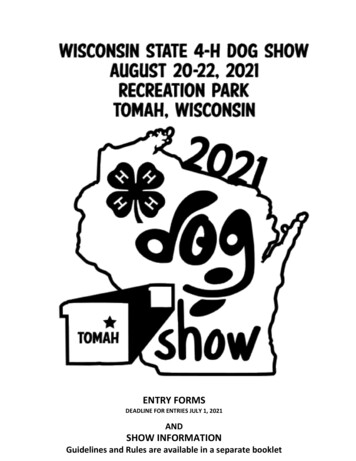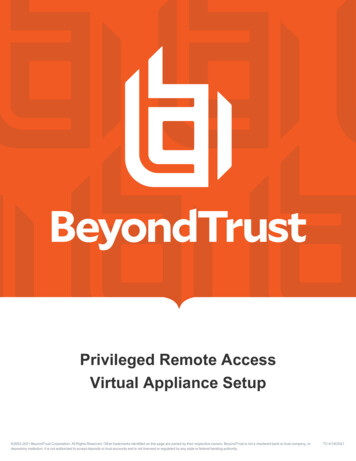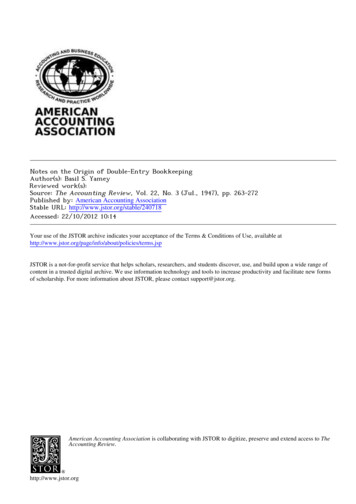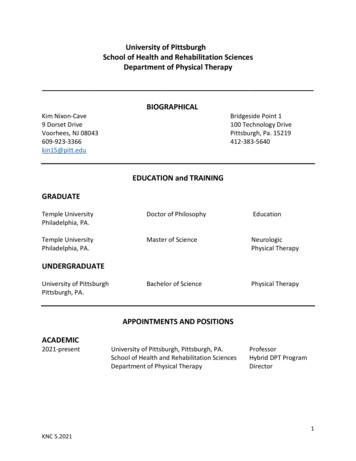
Transcription
Virtual Entry Assessment MC(474) - Mail Carrier JobsMail CarrierCity CarrierCity Carrier AssistantRural Carrier Associate
Postal exam 474, also called Virtual Entry Assessment MC 474 and theMail Carrier VEA Exam, is the newly launched test used to fill alldelivery positions including City Carrier, City Carrier Assistant, CasualCity Carrier, Rural Carrier, Rural Carrier Associate, and Assistant RuralCarrier.After applying for one of these jobs, you are sent an email withinstructions and a link for taking the test. You must complete the examwithin 72 hours of applying. If you do not complete the exam within 72hours, your application is deleted. If you do not complete the examwithin 72 hours, you can apply for other jobs that become available,but you will not be considered for the original job you applied for.This is a self-administered exam that lasts about 45 minutes. You takeit on your own at home or wherever you choose. You do not have totravel to a supervised testing site to take it.You can use a computer, a tablet, or a smart phone to take the exam.At the beginning of the test, you must select which of these devicesyou will be using.You are encouraged to complete the exam in one sitting, but you canexit the exam and return to finish it later if so desired. Your answersare saved up to the point you left the exam, and you are able pick it upand start again where you left it. But as previously mentioned,whether you finish the test in one sitting or leave it and come back tofinish it later, you still must complete the exam within 72 hours ofapplying.The test is formatted as a slide show with audio narration. Allinformation, instructions, and questions are given both verbally and inwriting as you progress from screen to screen.Your score is available immediately upon completion of the exam. Tosee your score, log into your eCareer Candidate Profile on the PostalService website. Your score can be found under the “Assessments” tab.
The highest possible score is 100, and the passing score is 70. (Militaryveterans entitled to preference points may be able to score slightlyhigher than 100.) If you fail or score below 70, rather than being givena numerical score, you are simply ranked as ineligible. The PostalService will release no info about the scoring formula for this exam,and it is not possible to find out why you made a certain score.It is imperative that you achieve the highest possible score due to thePostal interview policy. This policy states that only the top threescoring applicants are invited for an interview. You must have one ofthe top three scores for any chance whatsoever.And you absolutely must make the highest possible score right nowwhen you have the chance because, whether you pass or fail, you willnot be able to take this exam again for twelve months. If you blow itnow by failing or by not getting a high enough score, you are out of luckfor a whole year. You can apply for jobs filled from different testsduring that one year period, but you will not be able to apply for jobsfilled from this exam.Exam 474, by the way, is very similar to exam 477 which is used to fillcustomer service jobs. It is logical that these two exams are similarsince they both fill jobs that deal with customers. Exam 474 fills jobsdelivering mail to customers, and exam 477 fills jobs serving customersat the front counter.Why Preparation for this Exam Is So EssentialThere are various types of test preparation needed for different kindsof exams. Preparation for this exam is critical so that you know exactlywhat to expect and so that you will not be blown away by the bizarrequestions and the odd way they are to be answered. All the questionson this test - literally 100% of the questions - fit this bizarredescription. It is not unusual for applicants to fail because they neverreally understand the questions or how to answer them.What is so strange about the questions and answers on this exam?
The questions are all multiple choice where you are to select an answer thatbest fits you, your probable response to a work situation, your experience, your preferred approach to work, your personality, etc.The questions are mostly theoretical or hypothetical in nature and can often bemisunderstood or not understood at all. Any or all of the answer choices can seem reasonable depending upon yourparticular personality and experience, and there is never one obvious answerthat stands out as the best choice. In fact, different answers can be thecorrect choice for different people and/or for different jobs. In one section of the exam you are to select two answers, the action you wouldbe most likely to take and the action you would be least likely to take inresponse to a given situation. In another section, each question consists of two descriptions that may bequite similar or radically different. You are to choose which description ismore like you and then choose to what degree it is like you.Although the scoring formula for this exam is not known, we do knowthat the Postal Service scores you by (1) creating a profile of you basedupon your answers to these bizarre questions and then (2) comparingyour profile to a theoretical profile of a theoretical perfect employee.And the theoretical profile of a theoretical perfect employee variesfrom one job to another. A numerical score is somehow developedbased upon this comparison of profiles.Preparation is also important to overcome Test Anxiety, a very realproblem that causes applicants to perform below their potential and toscore poorly. Test Anxiety can only be overcome by becoming familiarand comfortable with exam content. That is especially true on astrange exam like this one. That is one of the reasons we give you suchdetailed information about the exam and such realistic practice testquestions. By the time you complete this guide, you will know exactlywhat to expect, and you will feel cool, calm, and confident whentaking the exam.You may expect a test prep guide to tell you what answers to choose onthis exam, but that is simply not possible on a test like this. Applicants
sometimes try to choose answers that they think would make them lookgood to the Postal Service rather than answers that reflect their truepersonality, preferences, etc. Some of these applicants get away withit and even get a job, but many who try it fail. Answering questions inthis fashion is known as test manipulation.We cannot in good conscience suggest that you manipulate this test bytrying to select answers you think they prefer. There are built-in trapsand indicators within the questions specifically designed to exposemanipulation attempts. The software that scores this exam isprogrammed to look for indications of manipulation and to deductsubstantial points from your score for each manipulation attemptindicated. Both ethically and practically, your best and only course isto answer honestly and sincerely. Attempts to manipulate this exammay end up being the fastest route to failure.Exam ContentThe exam consists of an introduction and three sections. Theintroduction, which lasts about five minutes, gives you a brief bit ofPostal Service history and a description of the jobs filled from thisexam. Following are a description, instructions, and a sample questionfor each exam section.Work Scenarios SectionThis section is called “Work Scenarios” on exams 474, 475, and 476, butit is called “Work Situations” on exam 477. This section usually takesabout seven minutes to finish. The instructions encourage you to workquickly, but it is not timed, so you can take as much time as you need.This section has eight questions, each of which describes a situationthat you might encounter on the job. The questions are presented oneper screen. As you move from one question to the next, you are takenfrom one screen to another. The four answer choices are potentialactions that you could take in response to the situation described. You
are to select two answer choices, the action you would be most likelyto take and the action you would be least likely to take.Select your answers by marking one answer choice on the left for theaction you would be most likely to take and one answer choice on theright for the action you would be least likely to take. As discussedabove, there are typically no obvious best answers for Most Likely or forLeast Likely. All the answer choices may seem reasonable. You mustsimply choose the most and least likely actions that you personallywould take.Once you have made answer choices by clicking your most and leastlikely actions, a “NEXT” button appears at the bottom right corner ofthe screen. Clicking this button takes you to the next question. But donot click the “NEXT” button until you are really ready to move onbecause you cannot return to the previous question once you click the“NEXT” button.Below is a sample Work Scenarios question. Most people will find thatall of the answer choices for this sample question seem reasonable.There are no obvious correct answers. You must nonetheless choosewhich you would be most and least likely to do in the situationdescribed.
Tell Us Your Story SectionThe Tell Us Your Story section consists of twenty questions about yourwork experience and background. The questions are presented one perscreen. As you move from one question to the next, you are taken fromone screen to another. For each question in this section, you onlyselect one answer choice by clicking it.This section usually takes about two minutes to complete. As with theprevious section, the instructions encourage you to work quickly, but itis not timed, so you can take as much time as you need.Immediately upon clicking an answer to a question, you will beautomatically taken to the next question. You can go back onequestion, but only one question, at any time if you need to doublecheck your previous answer.Below is a sample Tell Us Your Story question.
Describe Your Approach SectionThe Describe Your Approach section consists of 56 questions aboutnumerous topics such as your preferred approach to work, yourpersonality, how you relate to other people (especially coworkers andsupervisors), how you handle stress, etc. The questions are presentedone per screen. As you move from one question to the next, you aretaken from one screen to another. You only select one answer choicefor each question, but this is another case of bizarre questions and oddanswer choices.This section usually takes around six minutes to complete. Theinstructions encourage you to work quickly, but again it is not timed, soyou can take as much time as you need.Immediately upon clicking an answer to a question, you areautomatically taken to the next question. You can go back one
question, but only one question, at any time if you need to doublecheck your previous answer.Below is a sample Describe Your Approach question. It will be mucheasier to describe the questions and how to answer while you arelooking at the sample question.Here is how you answer questions in this section. You only select and click one answer choice for each question despite theconfusing structure of the questions. First choose which statement is more like you, the top statement or the bottomstatement. If the top statement is more like you, click either “Most like me” or “Somewhatlike me” under the top statement depending upon how well that descriptionfits you. For this question, if you are an outgoing person as stated at the top,
and if you are a very outgoing person, you might click “Most like me” under thetop statement. If the bottom statement is more like you, click either “Most like me” or“Somewhat like me” over the bottom statement depending upon how well thatdescription fits you. For this question, if you are a rather quiet - but not a veryquiet - person as stated at the bottom, you might click “Somewhat like me”over the bottom statement.The Describe Your Approach questions can indeed be bizarre.Sometimes the top and bottom statements can be quite opposite as inour sample question - outgoing vs. quiet. Other times the top andbottom statements seem to say the same thing in different words, so itis very difficult to choose an answer. And it is virtually never obviouswhich answer choice may be best.Complete Practice ExamFollowing is a complete practice exam. How realistic are thequestions? They are actual questions from the real test paraphrased sothey will not be in violation of copyright law.However, you may or may not see these specific questions when takingyour exam. There are a number of versions of the exam, and thedifferent versions have different questions. It may be that only a fewquestions are different, or all the questions may be different. Or youmay see the same questions but presented in a different order. If youhappen to take the same version that these practice test questionscame from, you will see these same questions in the same order but intheir original wording. Regardless of what questions you see, theactual exam will be formatted exactly like this practice test.As explained earlier, the Postal Service will not release any informationabout how this test is scored, so it is not possible to score this practiceexam. And there are no definitive right or wrong answers, so it is notpossible to provide an answer key. When taking both the practice examand the actual test, you are to answer the questions honestly and
sincerely, so answers that may be right for you . that accuratelydescribe you . may be wrong for another applicant.The purpose of the practice exam is therefore not to score you or tojudge the accuracy of your answers because such is simply notpossible. The purpose is to assure that you know exactly what toexpect when taking the real test, that you are not blown away by thebizarre questions, that you do not suffer from Test Anxiety, and thatyou are prepared to achieve your highest possible score.The practice exam is broken down into its various sections. You willtake it one section at a time. You can take all sections in a singlesitting or take them individually as preferred. You have unlimitedaccess and can return to the practice test as many times as you like.The actual exam is taken visually on a computer, tablet, or smart phonescreen. This practice exam is therefore taken the same way. To take itvisually, read the questions and review the answers choices on yourdevice screen, and then select answer choices in your mind. Markinganswers is not necessary since, per previous discussion, the practiceexam cannot be scored. The purpose of this practice exam is not to bescored since that is impossible. The purpose, as emphasizedthroughout this guide, is to assure that you know exactly what toexpect when taking the real test and that you do not suffer from TestAnxiety.Work Scenarios Practice TestYou are to select two answer choices for each of these eight questions,the action you would be most likely to take and the action you wouldbe least likely to take, in response to the described situation. Thissection usually takes about seven minutes to finish. You areencouraged to work quickly, but this section is not timed, so you cantake as long as you need.
Tell Us Your Story Practice Test
For each of the 20 Tell Us Your Story questions, select one answerchoice that best describes your experience or background. This sectionusually takes about two minutes to complete. You are encouraged towork quickly, but this section is not timed, so you can take as long asyou need.
Describe Your Approach Practice TestThe Describe Your Approach section has 56 questions and usually takesabout six minutes to finish. You are encouraged to work quickly, butthis section is not timed, so you can take as much time as you need.Each question consists of two statements, one at the top and one at thebottom. You are to (1) choose which statement (top or bottom) that ismost like you and then (2) select the answer choice - “Most like me” or“Somewhat like me” - for that statement that best fits you.
End of Practice Exam
best fits you, your probable response to a work situation, your experience, your preferred approach to work, your personality, etc. T h equestoi nsaremostyl t heoretci aol rhypot hetci ani l nat ureandcanoft enbe misunderstood or not understood at all. Any or all of the answer choices










